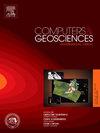基于小波数值积分和CUDA并行的海洋重力梯度模型计算
IF 4.2
2区 地球科学
Q1 COMPUTER SCIENCE, INTERDISCIPLINARY APPLICATIONS
引用次数: 0
摘要
与传统的重力观测相比,扰动重力梯度捕获了更多来自地球重力场的高频信息。由于难以直接获得重力梯度测量值,我们可以用Stokes积分法计算重力梯度。然而,这种计算过程面临两个主要问题:1)从原始函数的积分中获得解析表达式是困难的,需要使用数值积分方法;2)大量数据可能导致计算速度降低。本文采用切比雪夫小波数值积分来提高扰动重力梯度计算的积分精度。给出了基于切比雪夫小波积分的节点和权值的推导过程。同时,CUDA (Compute Unified Device Architecture)支持GPU的并行计算,提高计算速度。我们详细介绍了这些技术的应用,并将理论概念转化为实际的计算程序。海洋数据实验表明,将Chebyshev小波数值积分与CUDA并行计算相结合,不仅保证了计算精度,而且显著提高了计算效率。本文章由计算机程序翻译,如有差异,请以英文原文为准。
Marine gravity gradient model calculation based on wavelet numerical integration and CUDA parallel
Compared to traditional gravity observations, the disturbing gravity gradient captures more high-frequency information from the Earth's gravity field. Due to the difficulty in directly obtaining gravity gradient measurements, we can calculate the gravity gradient by the Stokes integral methodology. However, this computational process faces two main issues: 1) Obtaining an analytical expression from the integral of the original function is difficult, necessitating the use of numerical integration methods; and 2) Large volumes of data can lead to reduced computational speed. In our study, Chebyshev wavelet numerical integration is employed to improve the integration accuracy in calculating the disturbing gravity gradient. We also provide the derivation process for nodes and weights based on the Chebyshev wavelet integral. Concurrently, the Compute Unified Device Architecture (CUDA) enables parallel computing on the Graphics Processing Unit (GPU) to improve computational speed. We detail the application of these techniques and translate theoretical concepts into a practical computational program. Experiments conducted on marine area data illustrate that integrating Chebyshev wavelet numerical integration with CUDA parallel computing not only ensures precise calculations but also significantly boosts computational efficiency.
求助全文
通过发布文献求助,成功后即可免费获取论文全文。
去求助
来源期刊

Computers & Geosciences
地学-地球科学综合
CiteScore
9.30
自引率
6.80%
发文量
164
审稿时长
3.4 months
期刊介绍:
Computers & Geosciences publishes high impact, original research at the interface between Computer Sciences and Geosciences. Publications should apply modern computer science paradigms, whether computational or informatics-based, to address problems in the geosciences.
 求助内容:
求助内容: 应助结果提醒方式:
应助结果提醒方式:


